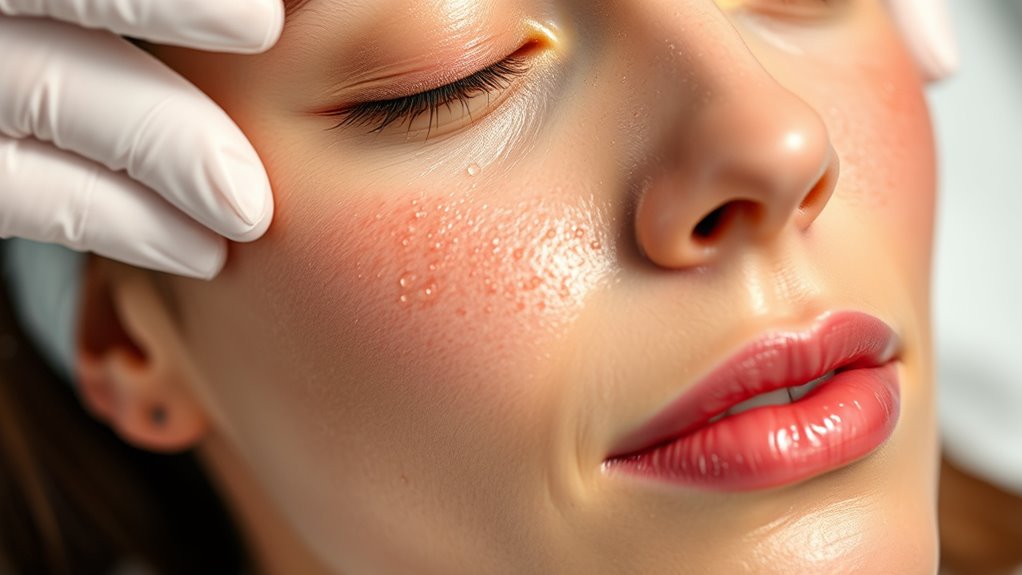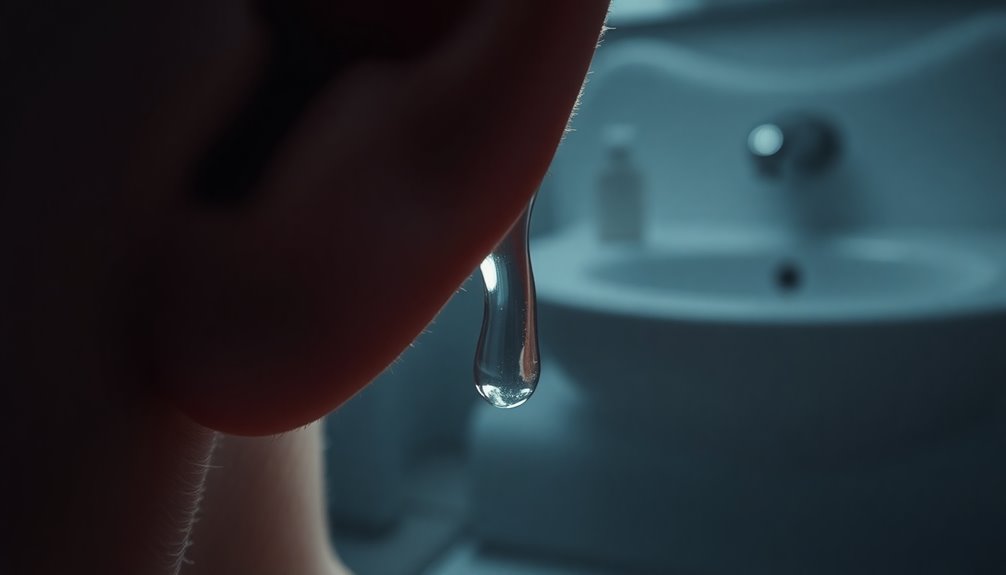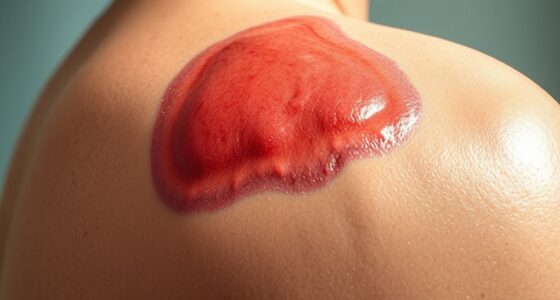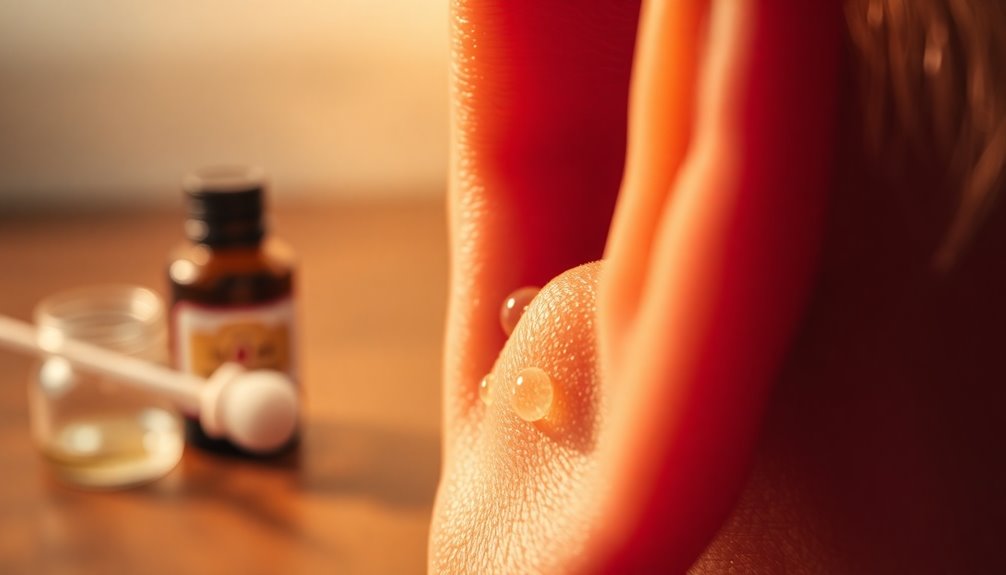A chemical peel involves applying a solution that exfoliates your skin, revealing smoother, fresher skin underneath. Before your appointment, avoid sun exposure, harsh products, or waxing, and inform your provider about medications. During the procedure, expect tingling or mild burning, which subsides quickly. Afterward, your skin might be red, flaky, and sensitive—so follow aftercare tips like moisturizing and sun protection. If you want to understand what happens next and how to care for your skin, keep exploring more details.
Key Takeaways
- Chemical peels involve applying a solution to exfoliate damaged skin, with types ranging from superficial to deep based on your needs.
- Expect sensations like tingling, warmth, or mild stinging during the procedure, which usually subside quickly.
- Post-peel, your skin may be red, flaky, and sensitive, requiring diligent hydration and sun protection.
- Recovery varies by peel depth, typically lasting a few days to a week, with gradual visible improvements over time.
- Follow your provider’s aftercare instructions closely to minimize risks, promote healing, and ensure optimal results.
Understanding Different Types of Chemical Peels
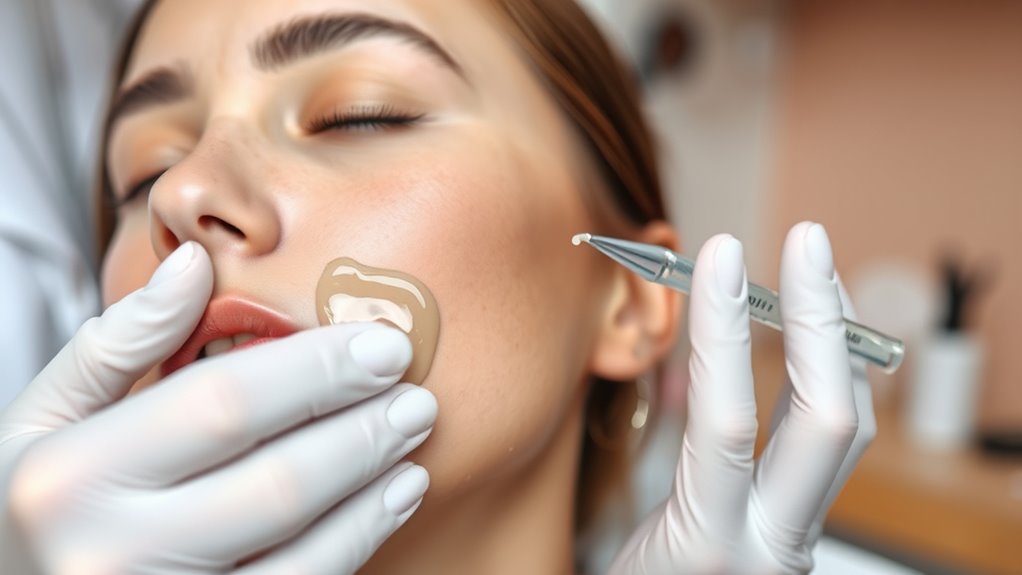
Have you ever wondered how different chemical peels target specific skin concerns? There are three main types: superficial, medium, and deep peels. Superficial peels use mild acids like alpha-hydroxy acids to exfoliate the outermost layer of your skin, ideal for minor discoloration or rough texture. Medium peels typically employ trichloroacetic acid, penetrating deeper to treat moderate sun damage, age spots, and fine lines. Deep peels, often using phenol, go through several layers of skin, effectively reducing more severe wrinkles and scars. Each type varies in strength, recovery time, and results. Understanding these differences helps you choose the right peel for your goals. Consulting with a professional ensures you select the appropriate peel tailored to your skin’s needs and concerns. Additionally, knowing skin layer depth can help you understand how each peel affects different skin structures for optimal results.
Preparing for Your Chemical Peel Appointment

Before your chemical peel, you’ll need to follow specific skin preparation steps, like avoiding certain skincare products. Make sure to discuss any medications you’re taking, especially those that increase photosensitivity. Additionally, you’ll receive instructions for the day before your appointment to guarantee your skin is ready for the treatment. Understanding precious metals investment options can also help you make informed decisions about protecting your assets during your overall financial planning.
Skin Preparation Steps
To guarantee your chemical peel delivers the best results and minimizes potential complications, proper skin preparation is essential. Begin by avoiding sun exposure for at least two weeks before your appointment, as tanned skin increases the risk of side effects. Follow your provider’s instructions carefully, which may include using a gentle cleanser twice daily to remove oils and dirt. You might also need to apply a prescribed or recommended topical agent, such as a retinoid or a bleaching cream, to enhance peel results. Stay consistent with skin care routines and avoid harsh scrubs or exfoliants in the days leading up to your appointment. Proper preparation helps assure your skin reacts well to the peel and promotes ideal healing afterward.
Medication Considerations
Certain medications can affect how your skin responds to a chemical peel or increase the risk of side effects. Some drugs, like retinoids, antibiotics, or blood thinners, can make your skin more sensitive or prone to irritation. It’s essential to inform your provider about all medications you’re taking. They may advise you to pause certain drugs before your appointment to minimize risks.
Imagine your skin as a delicate canvas:
| Medication Type | Effect on Skin |
|---|---|
| Retinoids | Increased sensitivity, peeling |
| Blood Thinners | Higher chance of bruising or bleeding |
| Antibiotics | Reduced healing, increased irritation |
| Anti-inflammatory | May reduce inflammation response |
Day Before Instructions
As you prepare for your chemical peel appointment, paying attention to your skin and medication routines can help guarantee the best results. In the days leading up to your appointment, avoid excessive sun exposure and wear sunscreen daily. Refrain from using harsh exfoliants, retinoids, or any skincare products that could irritate your skin at least 48 hours beforehand. Stay well-hydrated and keep your skin moisturized to ensure it’s in prime condition. If your dermatologist prescribed any medications or ointments, follow their instructions carefully. Avoid waxing, tweezing, or any hair removal treatments on the treatment area a few days prior. Being gentle with your skin helps reduce the risk of irritation and ensures a smoother, more effective peel. Incorporating fraud detection techniques into your transaction processes can also help protect your business from potential risks.
What Happens During the Procedure
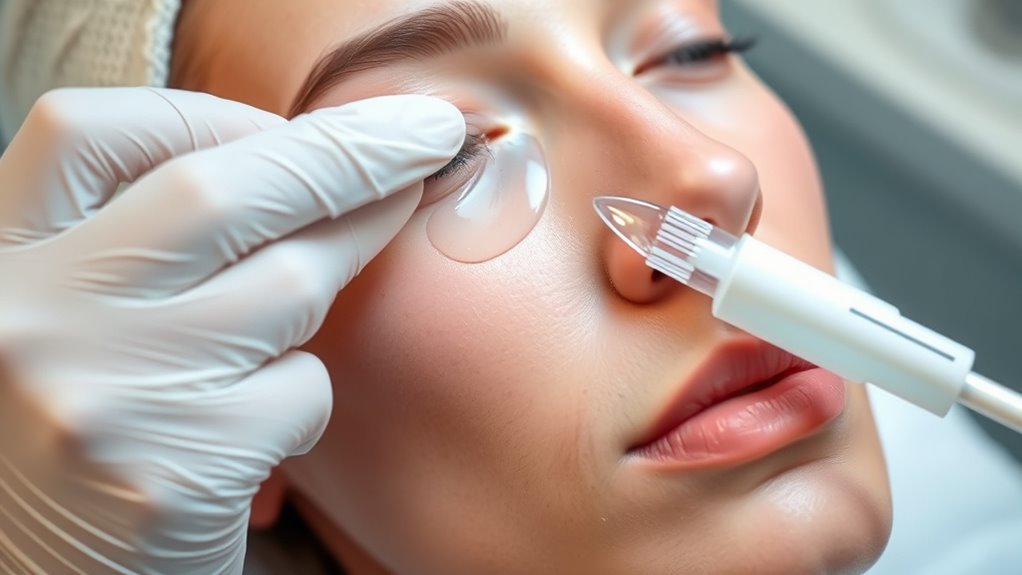
During the procedure, your provider will apply the peel solution to your skin, and you might feel a tingling or burning sensation. Once the solution is on, you’ll need to follow post-procedure care instructions to help your skin recover. Knowing what to expect can make the experience more comfortable and effective. Being aware of potential AI vulnerabilities can also help you better understand safety considerations related to cosmetic procedures.
Application of Peel Solution
When applying the peel solution, the skincare professional carefully cleanses your skin to remove oils and debris, ensuring the peel adheres evenly. They then use a brush or applicator to apply the solution in thin, uniform layers. The solution penetrates your skin quickly, targeting the damaged layers. During this process, they monitor the reaction, which may include slight redness or tingling. The peel’s strength determines how long it stays on your skin, typically between a few minutes to half an hour. Here’s an overview of the process:
| Step | Description |
|---|---|
| Cleansing | Removes oils and debris |
| Application | Evenly spreads peel solution |
| Monitoring | Checks for reaction and comfort |
| Timing | Maintains application duration |
| Removal or Neutralization | Cleanses or neutralizes the peel |
A dermatologist may also recommend post-peel skincare to enhance healing and results.
Sensation During Treatment
You might feel a range of sensations as the peel solution reacts with your skin. Expect a tingling or warming feeling that can vary from mild to intense, depending on the peel’s strength. Some people experience a slight stinging, similar to a prickling sensation, which usually subsides quickly. You may also notice a faint burning or itchiness as the solution works to exfoliate your skin’s top layers. These sensations are normal and indicate the peel is active. To help you stay comfortable, your provider might apply a cooling compress or a soothing serum during the process. Keep in mind, each person’s experience is different, but these sensations typically don’t last long and are part of the peeling process.
Post-Procedure Care
Immediately after the peel, your provider will give you specific instructions on how to care for your skin. You’ll likely be advised to keep your skin moisturized and avoid picking at any peeling areas. Use gentle cleansers and avoid harsh products like scrubs or acids for a few days. Applying a broad-spectrum sunscreen is essential, as your skin will be more sensitive to sunlight. You might experience some redness, swelling, or peeling, which is normal. Stay hydrated and avoid strenuous activity that causes sweating. Follow any prescribed treatments, such as ointments or antioxidants. Regularly check your skin for signs of unusual reactions, like excessive pain or infection. Proper post-care helps guarantee your skin heals smoothly and maximizes your peel’s results. Paying attention to skincare patch application timing can also support your recovery process.
Immediate Aftercare and Expectations
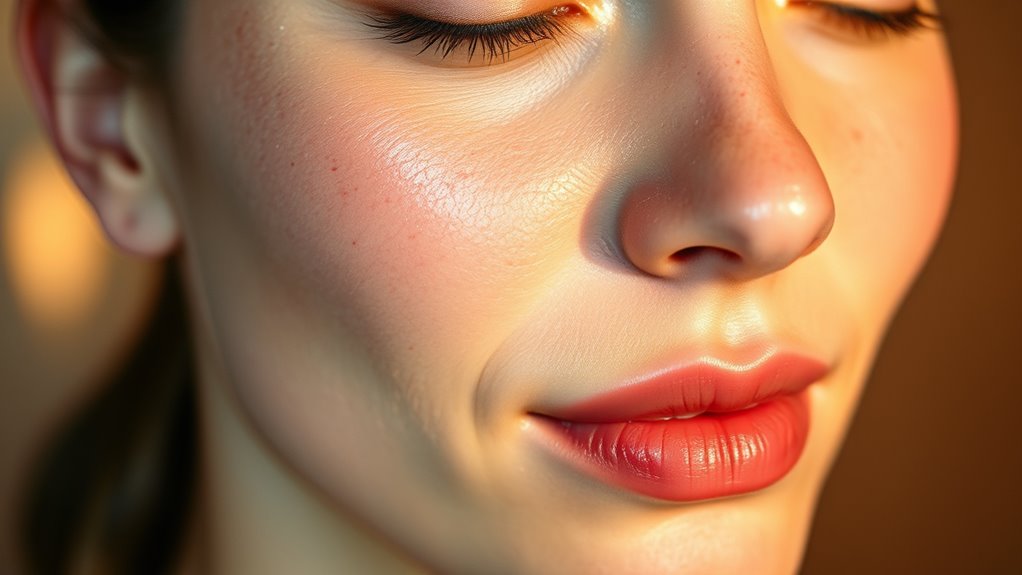
After a chemical peel, proper immediate aftercare is essential to support healing and achieve the best results. You should follow your provider’s instructions carefully to minimize risks and optimize your skin’s recovery. Expect your skin to be sensitive, red, and possibly flaky in the hours and days after the procedure. Keep the skin hydrated by applying gentle, recommended moisturizers, and avoid picking or scratching. Protect your skin from sun exposure at all times, as it will be more vulnerable.
Additionally, using trusted skincare products can help ensure that your skin remains healthy and free from irritation during this sensitive time.
Remember these key points:
- Apply only approved skincare products and avoid harsh ingredients.
- Use broad-spectrum sunscreen daily, even if you’re indoors.
- Avoid strenuous activities that cause excessive sweating; give your skin time to heal.
Managing Discomfort and Side Effects

Managing discomfort and side effects after a chemical peel involves taking steps to soothe your skin and reduce symptoms. You might experience redness, peeling, or mild irritation, but these usually improve quickly. Using gentle creams or prescribed ointments can help calm your skin. Applying cold compresses reduces inflammation and discomfort. Avoid harsh scrubs or picking at peeling skin to prevent scarring. Hydrate well and stay out of the sun to minimize irritation. Here’s a quick guide:
| Symptom | Management Tip | When to Seek Help |
|---|---|---|
| Redness | Apply cool packs and moisturize | If redness persists beyond a week |
| Peeling | Use gentle moisturizer | If peeling is excessive or painful |
| Itching | Use antihistamine creams | If itching worsens or spreads |
| Sensitivity | Avoid sun exposure | If severe or lasts long |
| Discomfort | Take OTC pain relievers if needed | If pain is intense or persistent |
Additionally, proper hydration and sun protection are essential to support healing, and self water management techniques from plant care can serve as a reminder to keep your skin well-moisturized during recovery.
The Recovery Timeline and Skin Care Tips

The recovery timeline after a chemical peel varies depending on the depth of the treatment and your skin’s response. Typically, you’ll notice peeling and redness for a few days to a week. During this time, it’s vital to follow proper skin care to support healing. Avoid picking at peeling skin to prevent scarring. Keep your skin moisturized and use gentle cleansers. Protect your skin from the sun with broad-spectrum SPF, as it will be more sensitive. Incorporating gentle skincare routines can help minimize irritation and promote faster healing.
Key skin care tips include:
- Applying moisturizer regularly to keep skin hydrated
- Avoiding harsh exfoliants or aggressive products
- Staying out of direct sunlight and wearing SPF daily
Following these tips helps guarantee a smoother recovery and the best possible results.
When to Expect Results
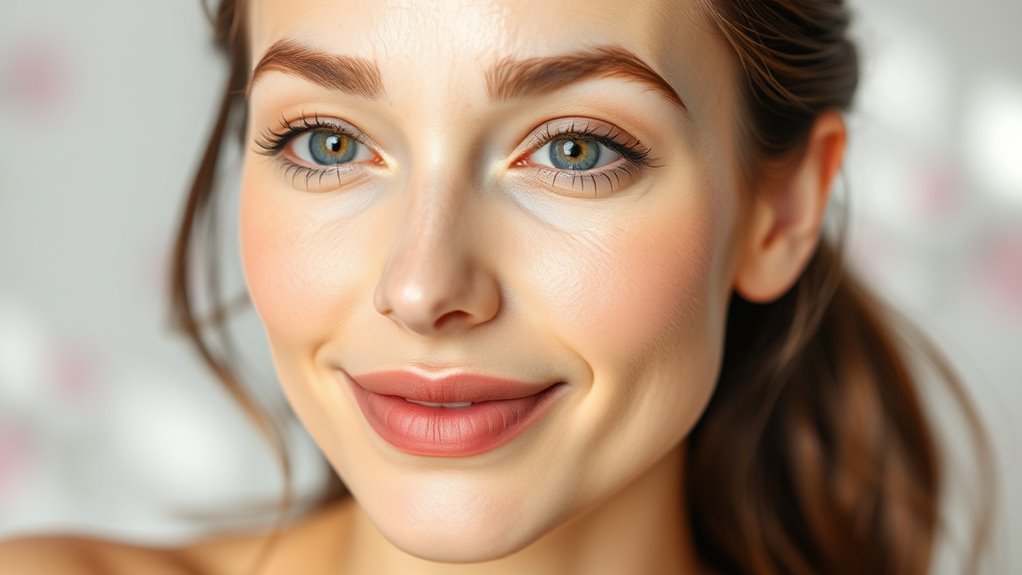
You can typically expect to see visible improvements within a few days to a week after your chemical peel, depending on the depth of the treatment. For lighter peels, you might notice a brighter complexion and smoother skin within days. Deeper peels usually take longer to show results, as your skin needs more time to heal and regenerate. You may see a reduction in fine lines, dark spots, or uneven skin tone over the following weeks. Keep in mind that full results often develop gradually as your skin continues to improve and new, healthy cells surface. Patience is key, especially with deeper peels, which require more recovery time. Glycolic acid products, known for exfoliation and skin renewal, can support your skin’s healing process and enhance results. Consistent skincare and sun protection will help optimize your results over the coming weeks.
Possible Risks and How to Minimize Them

While chemical peels are generally safe when performed by a trained professional, they do carry some risks such as redness, swelling, and irritation. To minimize these, follow your provider’s aftercare instructions diligently. Protect your skin from sun exposure by applying broad-spectrum sunscreen and wearing protective clothing. Avoid picking or scratching at your skin, which can cause scarring or infection. Keep your skin moisturized and stay away from harsh skincare products until fully healed. Being aware of these risks helps you take proactive steps to reduce complications. If you experience severe pain, blistering, or signs of infection, contact your provider immediately. Staying informed and cautious guarantees a safer healing process and better results from your chemical peel.
Choosing the Right Professional for Your Treatment
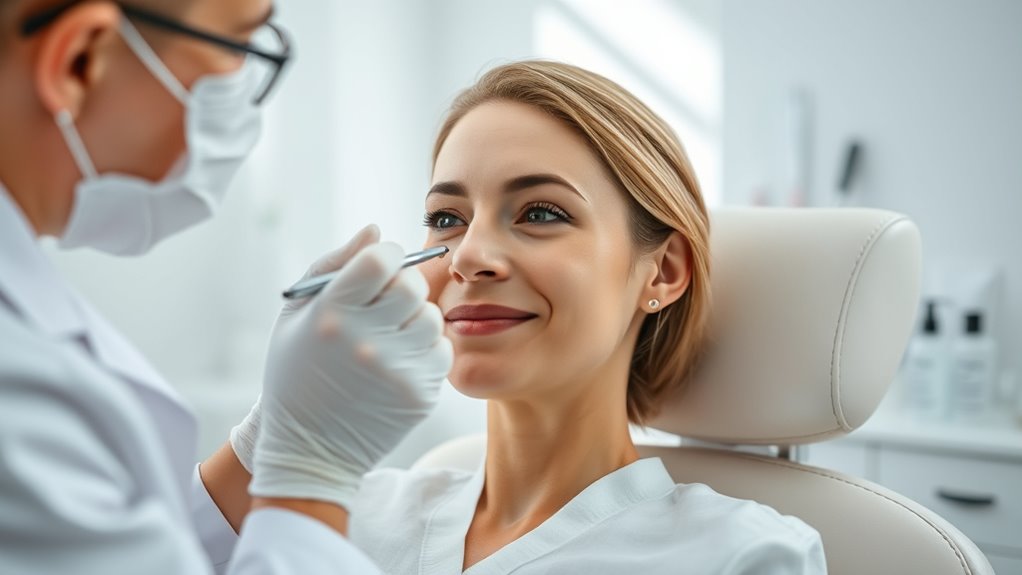
Choosing the right professional for your chemical peel guarantees you get safe, effective results. Look for a licensed dermatologist, plastic surgeon, or certified skincare specialist with specific experience performing chemical peels. Check their credentials and ask about their training and success rate. Don’t hesitate to review before-and-after photos of previous clients to gauge their expertise. A qualified professional will evaluate your skin type, concerns, and medical history to recommend the best peel strength and type. Avoid unlicensed practitioners or those offering cheap, quick treatments without proper assessment. Trust your instincts—choose someone who listens, explains the process clearly, and makes you feel comfortable. Proper guidance guarantees your peel is safe, effective, and tailored to your skin’s needs.
Frequently Asked Questions
How Often Should I Get Chemical Peel Treatments?
You might wonder how often you should get chemical peel treatments. It depends on your skin type and goals, but generally, treatments are recommended every 4 to 6 weeks. For mild peels, you can go closer to every month, while deeper peels may require longer intervals. Always consult your dermatologist for personalized advice to guarantee safety and ideal results. Regular treatments can improve skin texture and tone over time.
Can I Wear Makeup Immediately After a Peel?
You wonder if you can wear makeup immediately after a peel. Generally, it’s best to avoid applying makeup right away, as your skin needs time to recover and breathe. Wearing makeup too soon can clog pores, cause irritation, or interfere with healing. Instead, focus on gentle skincare, keep your skin protected, and wait until your skin is fully healed before reintroducing makeup. Your skin will thank you for the patience.
Are Chemical Peels Suitable for All Skin Types?
You wonder if chemical peels suit all skin types. While they can benefit many, not everyone is an ideal candidate. If you have sensitive, very dark, or active skin conditions, you might need to avoid certain peels or opt for gentler options. It’s best to consult with a skincare professional who can assess your skin’s unique needs and recommend the most suitable treatment for you.
What Should I Avoid Before My Appointment?
Before your appointment, you should avoid sun exposure, tanning beds, and using harsh skincare products like retinoids or acids for at least a week. Don’t pick at your skin or use exfoliants to prevent irritation. Stay away from any treatments that could make your skin sensitive, and follow your dermatologist’s instructions closely. Doing this helps make sure your peel goes smoothly and gives you the best results possible.
How Long Do Chemical Peel Results Typically Last?
Imagine your skin glowing like a radiant sunrise—that’s the magic of your chemical peel results. Typically, they last about 3 to 6 months, depending on your skin type and how well you care for it afterward. To make the most of your glow, stay consistent with your skincare routine, protect your skin from the sun, and consider periodic touch-ups. With proper care, your refreshed look can shine longer.
Conclusion
By understanding the different types of chemical peels, preparing properly, and following aftercare instructions, you’ll set realistic expectations, minimize risks, and maximize results. Knowing what to expect during and after the procedure helps you feel confident and in control. Embrace the journey to healthier, glowing skin by staying informed, being patient, and caring for your skin. Because with the right knowledge, preparation, and care, you’ll achieve the radiant results you desire—and enjoy the confidence that comes with it.
